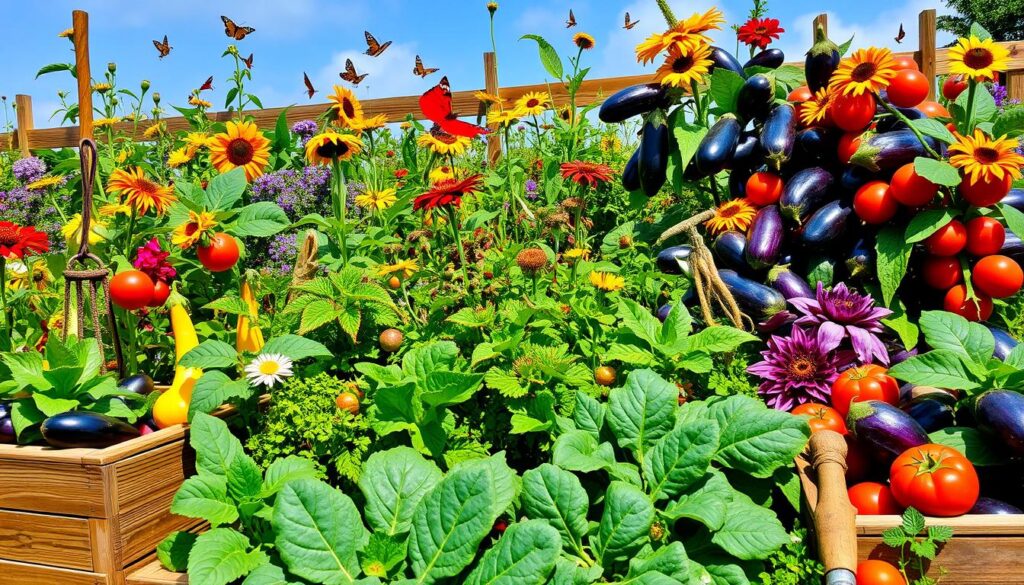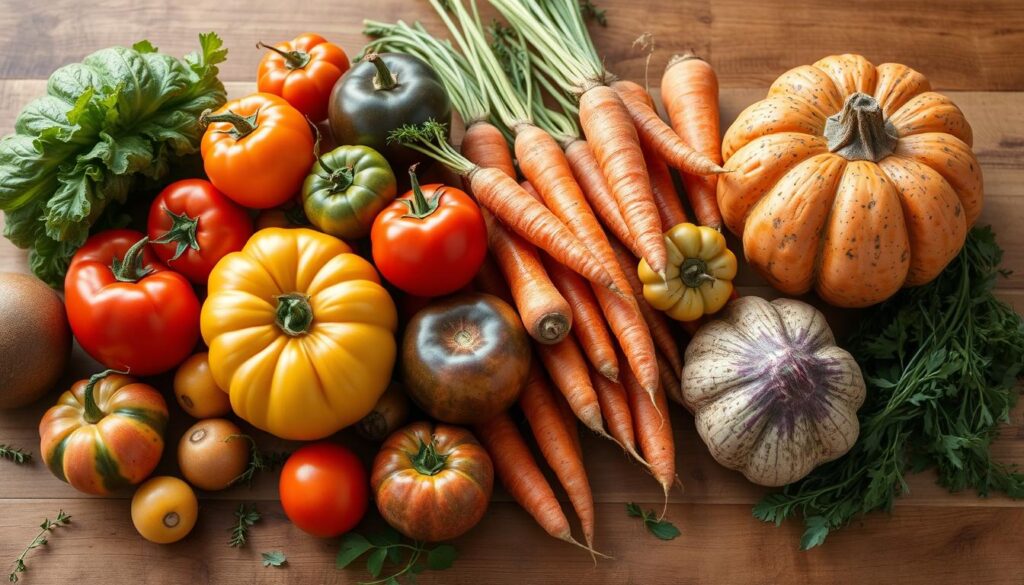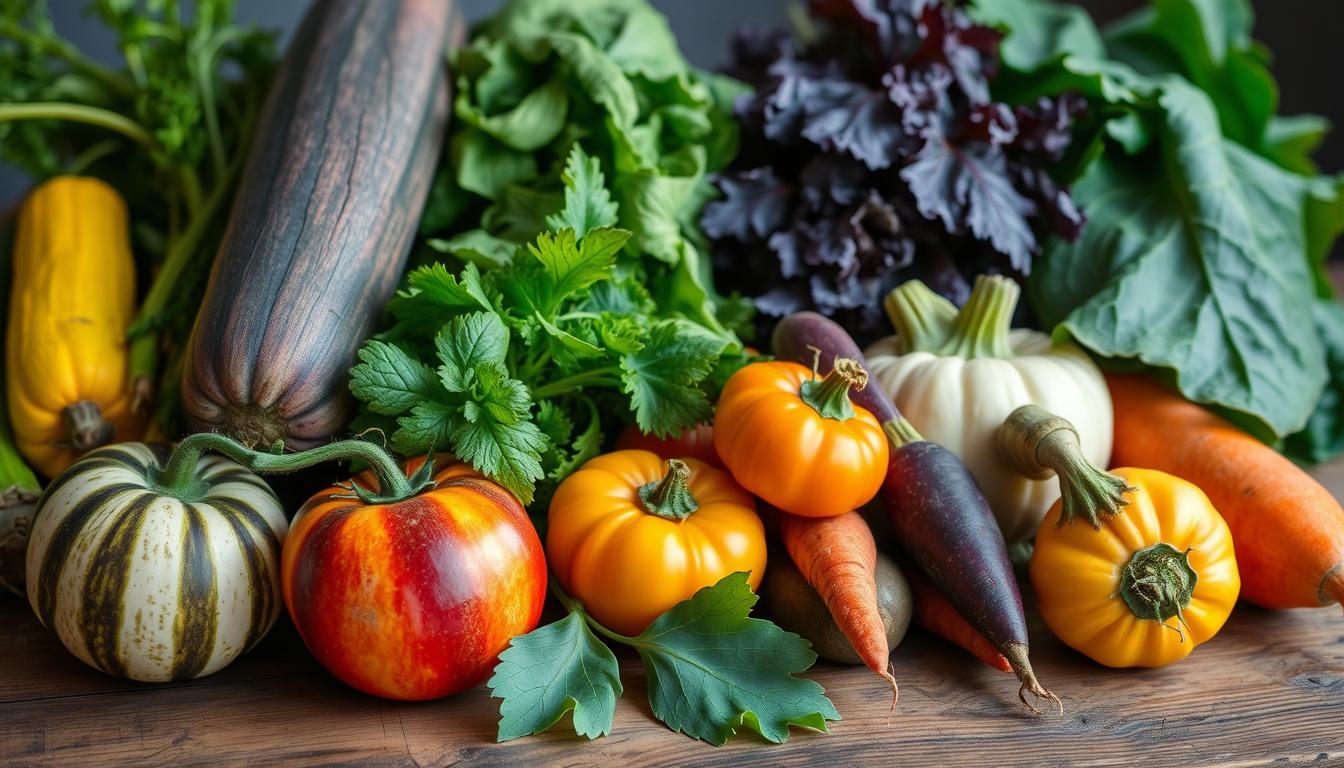I’m thrilled to share my knowledge about heirloom vegetables with you. This guide is perfect for both new and seasoned gardeners. It will teach you how to grow your own heirloom produce.
You’ll learn about heirloom varieties, their history, and how to plant, care for, and harvest them. This article is your key to starting your heirloom vegetable gardening adventure.
Key Takeaways
- Heirloom vegetables are open-pollinated plant varieties that have been passed down for generations, often with unique flavor profiles and visual characteristics.
- Growing heirloom vegetables offers numerous benefits, including increased nutrient content, preservation of genetic diversity, and the opportunity to connect with traditional growing practices.
- Selecting the right heirloom seeds, preparing your garden, and implementing proper planting and care techniques are crucial for a successful heirloom vegetable harvest.
- Saving seeds from your heirloom crops can allow you to continue growing your favorite varieties year after year, while also sharing them with your community.
- Embracing the joy of heirloom vegetable gardening can lead to a deeper appreciation for sustainable food systems and the rich culinary heritage they represent.
What Are Heirloom Vegetables?
Heirloom vegetables are a special type of produce with a rich history. They have been passed down for generations, often for over 50 years. This makes them unique compared to modern hybrid crops.
Definition and History
Heirloom vegetables are saved by families or communities for decades. They keep their unique genetic traits and flavors. Unlike hybrids, they are grown for their taste, colors, and ability to resist pests and environmental stresses.
Their history goes back centuries. Many varieties come from Native American, European, and Asian cultures. Gardeners and farmers saved these crops for their value, even during industrialization and commercial agriculture’s rise.
Benefits of Growing Heirloom Varieties
Heirloom vegetables have many benefits. They taste better, look unique, and are more nutritious. They also support biodiversity and preserve traditional farming methods.
| Benefit | Description |
|---|---|
| Exceptional Flavor | Heirloom vegetables have richer flavors than modern hybrids. |
| Unique Appearances | They come in vibrant colors, shapes, and sizes, enhancing gardens and dishes. |
| Nutritional Value | Many heirlooms have more vitamins, minerals, and antioxidants than hybrids. |
| Resilience | Heirloom vegetables resist pests, diseases, and environmental stresses better, needing less chemicals. |
Exploring heirloom vegetables’ definition, history, and benefits shows their value. They are a key part of preserving our agricultural heritage.
Choosing the Right Heirloom Seeds
Choosing the right heirloom seeds is key for new gardeners. They offer a wide range of unique, tasty vegetables. It’s important to find the best seeds for your area and gardening goals.
Exploring Heirloom Seed Sources
Start by finding good heirloom vegetable seeds. Look at local nurseries and online shops. Read reviews and ask other gardeners for advice.
- Local seed swaps and community gardens are great for finding selecting heirloom seeds for your area.
- Online heirloom seed companies have a huge selection. You can explore from home.
- Talking to local seed savers and gardening groups can help you find seeds and get tips.
Evaluating Heirloom Varieties
After finding sources, look at different varieties. Think about growing conditions, how long they take to grow, and what you want, like taste or color.
| Heirloom Vegetable | Ideal Growing Conditions | Unique Characteristics |
|---|---|---|
| Brandywine Tomato | Full sun, well-drained soil | Large, beefsteak-style fruit with a rich, complex flavor |
| French Breakfast Radish | Cool, moist soil | Elongated, cylindrical shape with a mild, slightly peppery taste |
| Purple Cherokee Tomato | Full sun, moderately fertile soil | Stunning, deep purple-red color with a sweet, almost fruity flavor |
By picking the right heirloom vegetable seeds, you’ll have a great garden. It’s all about finding the right seeds for your space.
“Heirloom seeds are like little time capsules, carrying the history and flavor of generations past. Choosing the right ones is the first step to unlocking the magic of your heirloom garden.”
Preparing Your Garden for Heirloom Vegetables
To grow a great heirloom vegetable garden, start with good soil and the right spot. These steps are key for your plants to grow well.
Soil Preparation for Heirloom Vegetables
Healthy soil is the base of a good heirloom garden. Start by adding compost to the soil. This makes it rich and feeds your plants well. Also, check the soil’s pH to make sure it’s right for heirloom plants, between 6.0 and 7.0. If it’s off, add lime or sulfur to fix it.
Selecting the Ideal Spot for Heirloom Veggies
Choosing the right spot is crucial for heirloom vegetables. They need lots of sunlight, at least 6 to 8 hours a day. The area should also have good air circulation and proper drainage to avoid water and disease problems. Think carefully about where to plant for the best results.
By carefully preparing the soil for heirloom vegetables and picking the best spot, you’re ready for a rich and tasty harvest.

“The secret to growing exceptional heirloom vegetables lies in the preparation of the soil and the selection of the ideal growing location.”
Planting Heirloom Vegetable Seeds
Planting heirloom vegetable seeds is a rewarding experience. It lets you grow unique and flavorful produce. Whether you start seeds indoors or directly outdoors, knowing the right timing and techniques is key.
Timing and Techniques
The best time to plant heirloom vegetable seeds varies by climate and crop. Usually, start planting heirloom vegetable seeds indoors 6-8 weeks before the last frost. This helps seedlings grow strong before moving outside.
When planting heirloom vegetable seed planting outdoors, check the sowing depth and spacing. Tomatoes and peppers need warm soil, so wait until it’s warm enough.
- Prepare the soil by loosening and amending it with organic matter to ensure optimal drainage and nutrient content.
- Sow the seeds at the appropriate depth, typically 2-4 times the diameter of the seed.
- Space the seeds according to the recommended spacing for each variety, allowing for proper growth and air circulation.
- Water the seeds gently after planting to help them establish.
By following these when to plant heirloom seeds guidelines, you’ll give your heirloom vegetable plants the best start. This sets the stage for a bountiful and flavorful harvest.
“The joy of growing heirloom vegetables is in their unique flavors, vibrant colors, and the connection to our agricultural heritage.”
Beginner’s Guide to Growing Heirloom Vegetables
Cultivating heirloom vegetables is rewarding for both new and seasoned gardeners. It’s more than just growing food. It’s about keeping our food’s cultural and genetic history alive.
Let’s get into the key steps for growing heirloom vegetables from seed to table:
- Seed Preparation: Choose and prepare your heirloom seeds well. Use soaking, scarification, or stratification to help them grow.
- Seedling Care: Give your seedlings the right light, water, and nutrients. This helps them grow strong and healthy.
- Transplanting: Move your seedlings to the garden carefully. This helps them adjust to their new home.
- Trellising and Supports: Use trellises and cages for vines and heavy vegetables. This helps them grow well.
- Ongoing Maintenance: Keep your garden watered, weeded, and pest-free. This ensures a great harvest.
| Heirloom Vegetable | Ideal Growing Conditions | Estimated Yield |
|---|---|---|
| Cherokee Purple Tomato | Full sun, well-drained soil | 10-15 lbs per plant |
| Lacinato Kale | Partial shade, nutrient-rich soil | 8-12 cups per plant |
| French Breakfast Radish | Full sun, loose, sandy soil | 20-30 radishes per plant |
By following these tips, you’ll grow a thriving heirloom vegetable garden. It will give you a rich and tasty harvest. Enjoy the journey of heirloom vegetable cultivation.
“Growing heirloom vegetables is not just about producing food – it’s about preserving the rich diversity of our culinary heritage.”
Caring for Your Heirloom Vegetable Garden
Keeping your heirloom vegetable garden alive and thriving takes a lot of care. You need to water them right and keep pests away. Each step is important for the health and growth of these special plants.
Watering and Mulching
Heirloom veggies need deep water and the right amount of moisture. Make sure the soil is moist but not too wet. This prevents diseases.
Putting down 2-4 inches of organic mulch helps keep the soil moist. It also stops weeds from growing.
Pest and Disease Management
Watching out for pests and diseases is crucial. Check your plants often for any damage or infestations. Fix problems quickly with safe methods.
Handpicking pests, using insecticidal soaps, and welcoming beneficial insects are good ways to protect your garden. They help keep the garden healthy without harming it.
| Pest/Disease | Symptoms | Organic Treatment |
|---|---|---|
| Aphids | Leaves wilting, curling, or turning yellow | Spray with insecticidal soap, encourage ladybugs |
| Powdery Mildew | White, powdery fungal growth on leaves | Apply baking soda or milk solution, improve air circulation |
| Tomato Hornworms | Large, green caterpillars munching on leaves and fruit | Handpick and dispose of, encourage parasitic wasps |
By watering heirloom vegetables correctly, mulching heirloom veggies, and using safe pest and disease management methods, you can keep your garden healthy and productive for a long time.
Harvesting Your Heirloom Vegetables
Knowing when and how to harvest your heirloom vegetables is key for their best taste and nutrition. Whether you’re new or experienced, learning to harvest heirloom vegetables right can greatly improve your crop quality.
To pick the right time for harvesting heirloom veggies, watch for visual signs and plant maturity. Each heirloom type has its own harvesting timeline. Knowing your plants’ specific traits is crucial.
Signs of Ripeness
- Look for vibrant colors and firm, plump textures in your heirloom vegetables.
- Check the size of the produce, as most heirloom varieties will reach their optimal size when ready for harvesting heirloom veggies.
- Gently press on the vegetable to ensure it’s not too soft or mushy, which could indicate overripeness.
Harvesting Techniques
- Use clean, sharp tools like pruners or knives to ensure a clean cut and prevent damage to the plant.
- Carefully remove the vegetable from the plant, taking care not to pull or tear the stem.
- Handle the heirloom produce gently to avoid bruising or crushing the delicate skin.
By following these tips, you’ll be well on your way to harvesting heirloom vegetables like a pro. Enjoy the full flavor and nutritional benefits of your homegrown heirloom produce.
“The true flavor of a vegetable is revealed at the moment of harvest.”
Saving Seeds for Next Season
One of the most rewarding things about growing heirloom vegetables is saving seeds for next year. Saving heirloom vegetable seeds lets you keep the special traits of your favorite plants. It also means you’ll always have your favorite varieties ready for the next growing season.
Proper Seed Saving Techniques
Learning how to save heirloom seeds is a skill every gardener should have. It doesn’t matter if you’re growing tomatoes, peppers, cucumbers, or pumpkins. The key steps of harvesting, drying, and storing your seeds are crucial for successful seed saving.
- Pick the healthiest, strongest plants from your garden to save seeds from.
- Wait until the seeds are fully ripe on the plant before you harvest them.
- Take the seeds and lay them out in a dry, well-ventilated area to cure for a few weeks.
- Put the dried seeds in airtight containers and keep them in a cool, dark spot to keep them fresh.
By using these heirloom seed saving techniques, you can look forward to a rich harvest for years. You’ll also help keep the genetic diversity of your favorite heirloom vegetables alive.
“Saving seeds from your heirloom garden is a rewarding way to preserve the past and ensure a bountiful future.”
| Heirloom Vegetable | Seed Saving Tips |
|---|---|
| Tomatoes | Ferment the seeds to remove the gel coating before drying. |
| Peppers | Allow the peppers to fully ripen on the plant before harvesting the seeds. |
| Cucumbers | Scoop out the seeds and dry them on a screen or paper towel. |
| Pumpkins | Clean the seeds thoroughly and dry them completely before storage. |
By mastering the art of saving heirloom vegetable seeds, you can have a steady supply of your favorite varieties. You can also share your harvest with other gardeners. It’s a rewarding way to keep the history and diversity of heirloom produce alive.
Sharing and Enjoying Your Heirloom Harvest
Growing heirloom vegetables is more than just gardening. It’s about celebrating their unique flavors and cultural heritage. As you enjoy your harvest, think about all the ways to share these special crops.
Heirloom produce offers endless culinary adventures. Create dishes like heritage tomato salads and roasted vegetable medleys. Share these with friends and family to explore the history behind each bite.
Sharing your harvest can also connect you with your community. Donate extra produce to food banks or shelters. Or, host a neighborhood swap meet to exchange heirloom vegetables. This builds community and raises awareness about heirloom varieties.
| Heirloom Vegetable | Recommended Uses |
|---|---|
| Heirloom Tomatoes | Salads, Sauces, Roasted Dishes |
| Heirloom Carrots | Roasted, Juiced, Raw in Salads |
| Heirloom Squash | Soups, Roasted, Grilled |
By sharing your harvest, you not only please the palate but also keep traditions alive. So, enjoy the fruits of your labor and let these vegetables bring joy to others.

Conclusion
Growing heirloom vegetables brings many benefits. They add unique flavors and colors to our meals. They also show our connection to the past.
Starting a garden with heirloom seeds is rewarding. It connects us to our agricultural heritage. Whether your space is big or small, it’s a journey worth taking.
Choosing the right seeds and caring for your garden are key. This guide helps you get the most out of these special plants. Growing heirloom veggies feeds your family and helps our planet.
Start your gardening journey with excitement. Enjoy every step and celebrate your wins. Share your harvest with loved ones. It’s a way to honor our farming traditions and connect with nature.



Leave a Reply